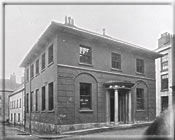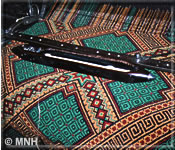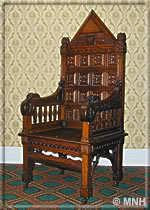Restoring the Old House
Its former glory…
 There are no known surviving images to indicate what the interior of the building would have looked like when it was in use as the House of Keys. The image on the right shows it as it was when being used by Parr’s Bank c1912-1913.
There are no known surviving images to indicate what the interior of the building would have looked like when it was in use as the House of Keys. The image on the right shows it as it was when being used by Parr’s Bank c1912-1913.
However, other physical and documentary sources of evidence give a clear basis to reconstruct the interior appearance of the Old House of Keys building.
The Building
Manx National Heritage began the restoration of the Old House of Keys in Millennium Year 2000. Although the building is less than 200 years old, it held many mysteries as to its original appearance and decoration. The uncovering of the evidence was an archaeological process as each successive layer of building and decorative work since 1820 was revealed. Scraps of original Victorian wallpaper and almost 200 years of paint layers were analysed and all available documentary evidence studied.
Documentary Evidence
Although there are no 19th century illustrations of the building or its interior, there is one description of the interior (a letter to the Rising Sun newspaper,1822). Although it is not very complimentary, this reference does provide an indication of the quality of the building in 1822.
‘…the most glaring defects in a public edifice are perceptible in the House of Keys: neither the exterior nor the interior of the building give any idea of its being a Senate House of a respectable body of Representatives, or rather the Parliament House of the Isle of Man…’ The Rising Sun newspaper. 19th January 1822
 Perhaps surprisingly, few items of furniture from the original chamber seem to have survived. However, two inventories have survived from 1866 and 1871 which list the contents of individual rooms in the House of Keys. These inventories provide descriptions of the furniture and fittings of the House, and also provide information such as the purchase dates of items. For example, the Brussels carpet and easy chair were bought in 1864, and a Milner in July 1865.
Perhaps surprisingly, few items of furniture from the original chamber seem to have survived. However, two inventories have survived from 1866 and 1871 which list the contents of individual rooms in the House of Keys. These inventories provide descriptions of the furniture and fittings of the House, and also provide information such as the purchase dates of items. For example, the Brussels carpet and easy chair were bought in 1864, and a Milner in July 1865.
The process of restoration starts by searching the building and documents for clues and information about the history of the building. The job of restoring all the elements of the original interior that have been lost over the years then begins; from the skirting boards, shutters and fireplaces through to the table and chairs – even down to the pewter inkwells.
 Wallpaper
Wallpaper
Ascrap of the original wallpaper concealed under layers of later wallpaper and paint was discovered. To reveal the original wallpaper design, the salvaged section was painstakingly restored by paper conservators at Manx National Heritage and the Museum of Domestic Design and Architecture in London.
The restored sample of wallpaper, a fashionable pattern of the 1860s, has been reproduced by Cole & Son of London.
Carpet
 Unfortunately nothing has survived of the original Brussels carpet listed in the 1866 and 1871 inventories. However, extensive research has resulted in a replica carpet produced by Woodward Grosvenor, carpet manufacturers in Kidderminster, who have been in operation since the 1790s and who have an historic archive of over 20,000 carpet designs covering a period of 200 years.
Unfortunately nothing has survived of the original Brussels carpet listed in the 1866 and 1871 inventories. However, extensive research has resulted in a replica carpet produced by Woodward Grosvenor, carpet manufacturers in Kidderminster, who have been in operation since the 1790s and who have an historic archive of over 20,000 carpet designs covering a period of 200 years.
The carpet woven for the Chamber of the House of Keys is in fact an 1864 design that would have been in production at the time that the Keys purchased their carpet, possibly even from Woodward Grosvenor.
Paint
Paint samples were taken for analysis from throughout the building by Patrick Baty. These detailed analyses provided evidence of decoration during the past 200 years and were used to reproduce the paint to original period specifications.
Furniture
 The two inventories of 1866 and 1871 provide the evidence for the two most important sets of furniture in the Chamber. There were 24 mahogany chairs and a large table. Other documentary evidence shows that the chairs were purchased just after the House was built but the table appears to be earlier in date. A set of 24 mahogany chairs have been reproduced in a design typical of the period 1815-1825, whilst the table is of an earlier design.
The two inventories of 1866 and 1871 provide the evidence for the two most important sets of furniture in the Chamber. There were 24 mahogany chairs and a large table. Other documentary evidence shows that the chairs were purchased just after the House was built but the table appears to be earlier in date. A set of 24 mahogany chairs have been reproduced in a design typical of the period 1815-1825, whilst the table is of an earlier design.
The original Speaker’s chair from the Chamber was given to Edward Gawne when he left the Keys following the first public elections in 1867. The replacement chair used by the new Speaker, John Senhouse Goldie-Taubman, which was in turn given to him on his retirement, was purchased by Manx National Heritage in 1993 and has now returned to its original home in the Chamber of The Old House of Keys.




Some detail views of the restored chamber.
